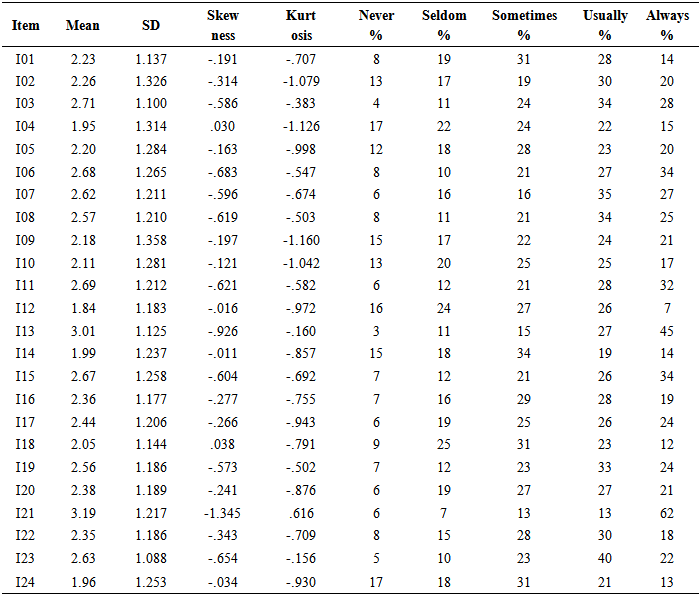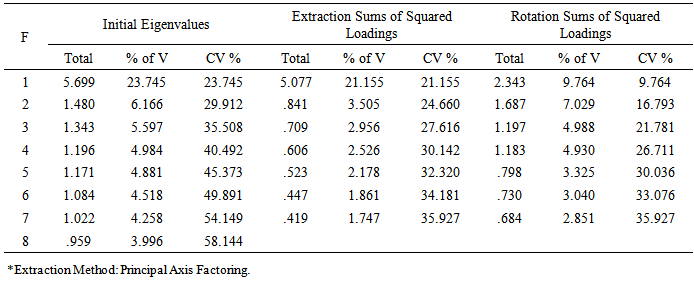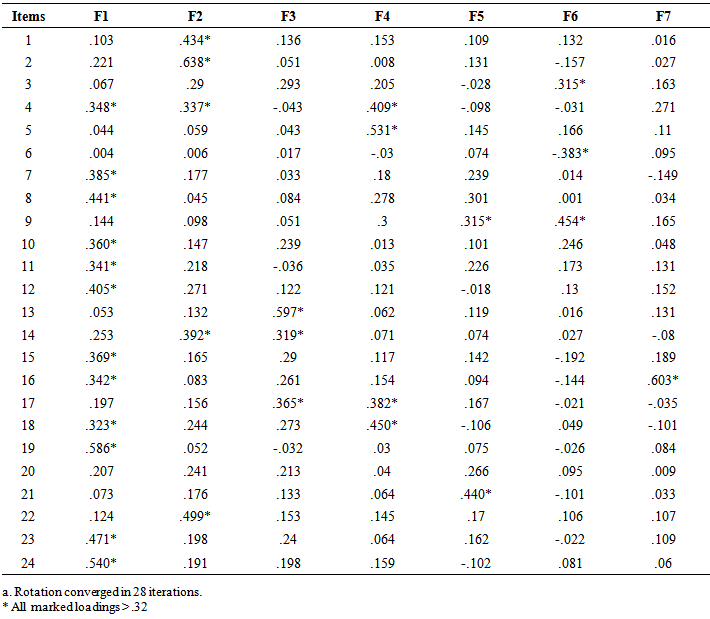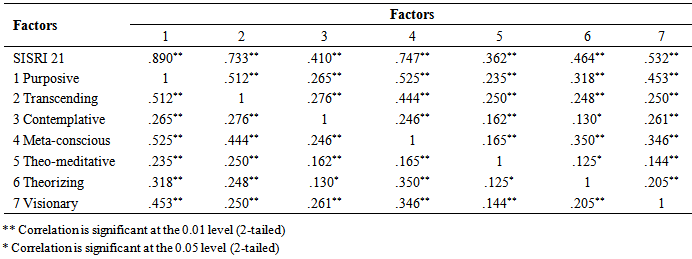-
Paper Information
- Paper Submission
-
Journal Information
- About This Journal
- Editorial Board
- Current Issue
- Archive
- Author Guidelines
- Contact Us
International Journal of Applied Psychology
p-ISSN: 2168-5010 e-ISSN: 2168-5029
2014; 4(4): 134-146
doi:10.5923/j.ijap.20140404.02
Spiritual Intelligence of Grade Three Senior High School Students in Iran: A Factorial and Theoretical Approach
Ebrahim Khodadady1, Ensiye Golbooie Moosavi2
1Ferdowsi University of Mashhad
2Ferdowsi University of Mashhad, International Branch, Mashhad, Iran
Correspondence to: Ebrahim Khodadady, Ferdowsi University of Mashhad.
| Email: |  |
Copyright © 2014 Scientific & Academic Publishing. All Rights Reserved.
This study explored the reliability and validity of the Spiritual Intelligence Self-Report Inventory (SISRI) designed by King (2008) when administered to students enrolled secondary education in Mashhad, Iran. To this end, the Persian version of the SISRI was administered to 344female grade three senior high school (G3SHS) students majoring in humanities, sciences, and mathematics. The subjection of the collected data to Principal Axis Factoring and rotating the extracted factors via Varimax with Kaiser Normalization. We found seven latent variables whose initial eigenvalues were one and higher, i.e., Purposive, Transcending, Contemplative, Meta-conscious, Theo-meditative, Theorizing, and Visionary. The inventory itself along with its Purposive, Transcending and Meta-conscious factors was found to be reliable. Since Contemplative, Theo-meditative, Theorizing and Visionary factors consisted of just one statement, their reliability could not be estimated. These four factors did, however, correlate significantly not only with each other but also with Purposive, Transcending and Meta-conscious dimension of spiritual intelligence. The results are discussed in terms of schema theory and suggestions are made for future research.
Keywords: Spirituality, Religiosity, Domains, Spiritual Intelligence Self-Report Inventory (SISRI)
Cite this paper: Ebrahim Khodadady, Ensiye Golbooie Moosavi, Spiritual Intelligence of Grade Three Senior High School Students in Iran: A Factorial and Theoretical Approach, International Journal of Applied Psychology, Vol. 4 No. 4, 2014, pp. 134-146. doi: 10.5923/j.ijap.20140404.02.
Article Outline
1. Introduction
- Zohar and Marshall (2000) defined spiritual intelligence (SQ) as the ability to access and use one’s experience of higher meaning and value. The application of terms such as “spirit”, “psych” and “higher meaning” was formerly rejected by many empiricists as “nothing more than irrational nonsense founded on a fear of the unknown” (King 2008, p. 121). However, the acceptance of abstract abilities such as moral and existential intelligences and treating them as distinct capacities by Gardner (1983) paved the way for some scholars to bring up the SQ as an intelligence which relates to peoples’ life and thus is worthy of scientific exploration.Believing that SQ suffered from a lack of scientific exploration, King (2008) developed a scale called the Spiritual Intelligence Self-Report Inventory (SISRI). The inventory has been chosen to be explored within an Islamic context in this study because it is a robust measure of spiritual intelligence widely employed in the literature. King composed 84 items and administered them to 631 undergraduate students enrolled in psychology courses at Trent University in Peterborough, Canada. Similar to Amram and Dryer (2008), he subjected his data to the principal component analysis (PCA) and Varimax with Kaiser Normalization (VKN) and extracted six factors. Based on the descriptive statistics of the items and their loading and cross loadings on the factors, King reduced the number of items to 42. In the second phase of his study, King (2008) administered the SISRI-42 to another groups of 321 undergraduate psychology students at Trent University. He utilized the structural equation modelling (SEM) module of Statistica 7.0 (Statsoft, 2006) for the initial confirmatory factor analysis (CFA) and adopted the Maximum likelihood as his method of parameter estimation. His results showed that the theoretically-supported four-factor model displayed a good fit to the data, i.e., Critical Existential Thinking (CET), Personal Meaning Production (PMP), Transcendental Awareness (TA) and Conscious State Expansion (CSE). Based on high residual correlations (above .14), high item correlations, and redundancy in item wording, he reduced the 42 items to 24. In order to ensure adequate factor structure and item loadings for the SISRI-24, King (2008) applied the PCA and VKN analyses to the final 24-item pool and found the SISRI-24 a highly reliable measure of SQ (α = .92) as was its CSE factor (α = .91). While the CET and PMP had the lowest alpha coefficient, i.e., .78 among the four factors, it reached .87 for the TA. As the first factor, the Critical Existential Thinking (CET) involves “the capacity to critically contemplate the nature of existence, reality, the universe, space, time, death, and other existential or metaphysical issues” (King, 2008, p. 57). Scholars such as Kiesling et al (2006) and Vaughan (2002) refer to the CET as “the ultimate questions” of life reflecting Gardner’s (1993) description of existential intelligence as “the intelligence of big questions” (p. 20). King (2008) resorted to Maslow’s (1964) acceptance of the existence of some individuals who are more advanced in their ability to contemplate existential matters to suggest that “theologians and philosophers occupy the higher end states” (p. 59). King (2008) defined the second factor, Personal Meaning Production (PMP) as “the ability to construct personal meaning and purpose in all physical and mental experiences, including the capacity to create and master a life purpose” (P. 61). It has been recognized as a component of spirituality by many scholars such as Kiesling et al. (2006), King et al. (2001), Koenig et al. (2000), Sinnott (2002), Wink and Dillon (200) and Worthington and Sandage (2001), required its consideration in a model of spiritual intelligence. King (2008) believed that Emmons’ (2000) “sanctification” is basically a form of personal meaning production. The PMP is also referred to as “spiritual meaning” (Meddin, 1998) and “religious meaning” (Krause, 2003) in the literature. As the third factor underlying the SISRI, Transcendental Awareness entails the ability to “identify transcendent dimensions of the self (e.g., a transpersonal or transcendent self), of others, and of the physical world (e.g., non-materialism, holism) during the normal, waking state of consciousness” (King, 2008, p. 64). It also calls for the ability to identify others’ to one’s self and to the physical. The term “transcendental” has been either used synonymously with spirituality or considered as one of its components by many scholars such as Elkins et al. (1988), Koenig et al. (2000), Martsolf and Mickley (1998), and Sinnott (2002). And finally, King (2008) defined the fourth factor, Conscious State Expansion, as “the ability to enter and exit higher / spiritual states of consciousness (e.g. pure consciousness, cosmic consciousness, unity, oneness) at one’s own discretion (as in deep contemplation, meditation, prayer, etc.) [p. 72]. The term “conscious” should be understood as “the awareness of environmental and cognitive events such as the sights and sounds of the world as well as one’s memories, thoughts, feelings, and bodily sensations” (Solso et al., 2005, p. 141). Experiencing higher consciousness has been considered as spiritual (Menon, 2005; Tart, 1975) and/or psychospiritual (Gackenbach, 1992). It is also viewed as a critical component of an individual’s spirituality and/or religiosity (Gackenbach, 1992; James, 1902/2002; Maslow, 1964; Menon, 2005; Tart, 1975).This study was designed to explore the single/ phrasal words comprising the statements constituting the SISRI in terms of their linguistic and cognitive relationships. The investigation was based on the micro-structural approach of schema theory (Khodadady, 2013). It also aimed to explore the factorial validity of the scale translated into Persian by the first author and one of his graduate students. It was hypothesized that the 24 statements comprising the Persian SISRI will load on the four factors established by King (2008). It was also assumed that the factors will relate to each other significantly.
2. Methodology
2.1. Participants
- Similar to Khodadady, Fakhrabadi, and Azar’s (2012) study, the participants of the present were 344 female grade three senior high school (G3SHS) students. (Male participants could not be recruited because of the restrictions imposed by the Bureau of Education stipulating collecting data from male participants by male researchers only. They were registered as full time students in AllamehAmini, Asma, Esmat, Farhikhtegan, ForoughHedayat, HazratKhadijeh, Hazrat Maryam, Imam Reza, Najibeh, Prf. Reza, Razaviyeh and Zeynabiyeh senior high schools. These schools were located in educational districts of one, two, three, four, five, seven and Tabadkan in Mashhad, Iran,. The participants were majoring in humanities (n = 143, 41.6%), sciences (n = 142, 41.3%), and mathematics (n = 59, 17.2%). Their age ranged between 15 and 20 (mean = 17.19, SD = .58). They spoke Persian (n = 331, 96.2%), Kurdish (n = 4, 1.2%), Arabic (n = 4, 1.2%), English (n = 3, .9%), and Turkish (n = 2, .6%) as their mother language.
2.2. Instrumentation
- Two instruments were employed in this study: a Demographic Scale and the Spiritual Intelligence Self-Report Inventory (SISRI) translated into Persian.
2.2.1. Demographic Scale
- Based on Khodadady, Taheryan, and Tavakoli’s (2012) study a Demogrphic Scale (DS) was developed to collect the data related to the participants’ age, school name, type of school, field of study, educational district, gender and mother language.
2.2.2. The Spiritual Intelligence Self-Report Inventory
- The 24-item Spiritual Intelligence Self-Report Inventory (SISRI) translated into Persian by the first author and Mr. Hamid KhosravaniFard was; used. The translation is based on schema theory which entails providing the best equivalents for the words comprising the source texts on the basis of their cognitive, linguistic and discoursal relationships with each other (see Khodadady, 2008; Khodadady & Eslami, 2013; Khodadady & Lagzian, 2013; Seif & Khodadady, 2003). The Persian statements which are given in Appendix were presented as multiple choice items to elicit the female G3SHS students’ responses objectively. The first item, for example, reads, “I have often questioned or pondered the nature of reality”. It requires each respondent to specify whether it is not at all true of her, i.e., never, not very true of her, i.e., seldom, somewhat true of her, i.e., sometimes, very true of true, i.e., usually, and completely true of her, always. The statements comprising the English SISRI loaded acceptably on four factors in King’s (2008) study, i.e., Critical Existential Thinking, Personal Meaning Production, Transcendental Awareness and Conscious State Expansion. It is a highly reliable measure of Canadian Undergraduate University (CUU) students’ spiritual intelligence (α = .92). The reliability coefficients of its underlying factors range from .78 to .91.
2.3. Procedures
- Since the second author of the present study was an officially employed teacher of English in Mashhad, Iran, she contacted her colleagues teaching in various schools and asked for their cooperation. This yielded 344 G3SHS students’ agreement, certain dates were set to administer the instruments of the study. The researcher attended the classes on the specified dates and administered the Persian SISRI in person. While the participants were taking the measures, she walked along aisles and interacted with them by answering their questions and reminding them to answer all the questions. They raised a number of questions dealing with higher states of consciousness. They were told that these states were attained when a person meditated and tried to make sense out of reality. The states, they were told, included “self-awareness, environmental awareness, spiritual awareness, or some combination of these” (King, 2008, p. 73). It was further elaborated that lucid dreams were, for example, considered as higher states of awareness (Tart, 1975). The completed scales were collected after about 15 minutes and both the students and teachers were thanked for their cooperation.
2.4. Data Analysis
- Following Khodadady (2013), the words comprising the SISRI were treated as linguistic schemata, parsed and classified into three domains, i.e., semantic, syntactic and parasyntactic. Each domain was further broken down into its constituting genera to have an objective measure regarding its linguistic complexity. Following King (2008), the descriptive statistics of the items comprising the SISRI was calculated to find out how well they had functioned. Based on Khodadady and Hashemi’s (2010) suggestion, Principal Axis Factoring was utilized to extract the factors underlying the inventory after it had been administered to the participants of this study. The initial eigenvalues of one and higher were adopted as the main criteria to determine the number of factors to be extracted. They were then rotated via Varimax with Kaiser Normalization. The reliability level of the SISRI as well as its underlying factors were estimated via Cronbach’s alpha. The factors were also correlated with each other to explore their relationships. All the statistical analyses were conducted via IBM SPSS Statistics 20 to test the two hypotheses below:H1. The four factors underlying the English SISRI will underlie its Persian version.H2. The Persian SISRI administered to G3SHS students will be as reliable as the English SISRI
3. Results
- The linguistic analysis of the schemata comprising the SISRI showed that it consists of 302 and 125 schema tokens and types, respectively, forming the semantic, syntactic and parasyntactic domains of the scale. Linguistic semantic domain consists of adjective, adverb, noun and verb genera which are traditionally known as “content words or contentives” (Crystal, 1991, p. 78). The analysis showed that King (2008) defined spiritual intelligence in terms of 43 (34.4%) nouns, 21 (16.8%) verbs, 16 (12.8%) adjectives and five (4.0%) adverbs. These genera do in fact represent the Canadian Undergraduate University (CUU) students’ spiritual intelligence as alinguistic domain consisting of 158 semantic schemata measured by the SISRI. Along with semantic schemata, 123 and 21 syntactic and parasyntactic schema tokens contribute to the measurement of spiritual intelligence by the SISRI, respectively. They are traditionally known as function words assuming a “largely or wholly” grammatical role (Crystal, 1991, p. 147). It is argued in this paper that the linguistic complexity of scales such as SISRI should be estimated first so that they can be studied in different contexts and be compared with similar or different scales. The complexity should be determined on the basis of schema types and tokens. The adjective schema “able”, for example, has been used seven times in the SISRI and thus has a token of seven. Based on semantic schema types, the SISRI has, therefore, a linguistic complexity of .68, i.e., 85÷125. (The tokens and types will be elaborated further in the Discussions section.)The descriptive statistics of items comprising SISRI are presented in Table 1. As can be seen, most mean values have generally clustered above the expected value of 2. These values show that almost all G3SHS students have agreed they have sometimes possessed or experienced the cognitive species presented within the linguistic statements comprising their spiritual intelligence domain. Statement nine, for example, brings up "developing personal theories about life, death, reality and existence". As can be seen, 67 percent of G3SHS students have sometimes (22%), usually (24%) and always (21%) done so. If never and seldom on the one hand and usually and always on the other are treated as the rarity and prevalence of such action, then it can be said that the percentage of G3SHS students who "develop their own theories of life" (45%) is more than those who do not (32%). The difference in the percentage was not, however, very large.
|
|
|
|
|
|
4. Discussions and Conclusions
- Khodadady (1997) addressed one of the most pressing issues in testing when he offered schema theory as a sound rationale to develop reliable and valid measures of reading comprehension ability. After reviewing the literature he argued that the ability has been rationally approached from three logical premises, top-down, bottom-up and interactive. While the top-down approach adopts broad terms such as “texts” and “messages” as the main unit of its analysis, the bottom-up advocates regard “words” as the building blocks of reading comprehension ability. Assuming the top-down and bottom up processes as unidirectional, the interactive approach, however, relates them to each other as the best way to explain reading comprehension ability involving the simultaneous application of top-down and bottom up processes.Khodadady and Herriman (2000) believed that the application of schema theory to reading comprehension ability had proved problematic because it had been defined in subjective, vague and broad terms evading any empirical validation and leading to the lack of a “generally agreed upon formal definition of a schema” (Ellis and Hunt, 1993, p. 245). Oxford (2002), for example, defined schemata as “increasingly intricate and differentiated mental structures” (p. 125). Similarly, Yule (2006) approached it as “a conventional knowledge structure that exists in memory” (p. 132). Khodadady (2001), however, defined schema as “any concept realized in a word or phrase, syntactic or semantic, closed or open, syntagmatic or paradigmatic, which can stand by itself or combine with other concepts to produce an idiosyncratic image in the mind of a given person. This image has a direct relationship with the person’s experiences with the concept gained through its application with other semantically and syntactically related concepts. Schemata are idiosyncratic because individuals differ from each other in terms of their experiences” (p. 111).By adopting the single/phrasal words constituting texts such as the SISRI, Khodadady and Herriman (2000) developed empirically valid schema-based cloze multiple choice item tests (S-Tests) to measure reading comprehension ability. Schema theory has also been employed to explain the functioning and validation of the SISRI in this study as Khodadady and Bagheri (2012) did with the statistical factors underlying their 33-item Religious Orientations Scale (ROS). According to them, the main construct measured by a scale such as ROS, i.e., religious orientations, can be viewed as a schema domain which can be subcategorized under several logically established genera and validated empirically by utilizing statistical analyses such as Principal Axis Factoring. Each genus or factor can in turn be subcategorized under species, types and tokens within a hierarchical organization. The theoretically and factorially validated categories can then be employed to explain the domain or construct under investigation both linguistically and cognitively. Figure 1 illustrated Khodadady and Bagheri’s (2014) cognitive and linguistic analysis of schemata constituting ROS. As can be seen, a linguistic explanation of the ROS requires specifying all the single and phrasal words forming its items as tokens whose types, species, and genera must be identified and categorized under the three broad domains of semantic, syntactic and parasyntactic schemata. The content validity of any scale, and reading passages for that matter, will depend on the items written or collected from the sources available. Cognitively, it reveals what each schema means to readers not only in and by itself but also in combination with other schemata as they form the items or species of scales. The species are, in fact, presented to the readers to determine the relevance of their constituting schemata to the genera underlying the construct by having the participants relate the species to each other on the basis of five choices, i.e., disagree completely, disagree, have no idea, agree and completely agree. The choices the participants make will depend cognitively on the activation of the experiences they have had with the concepts represented by the schemata.
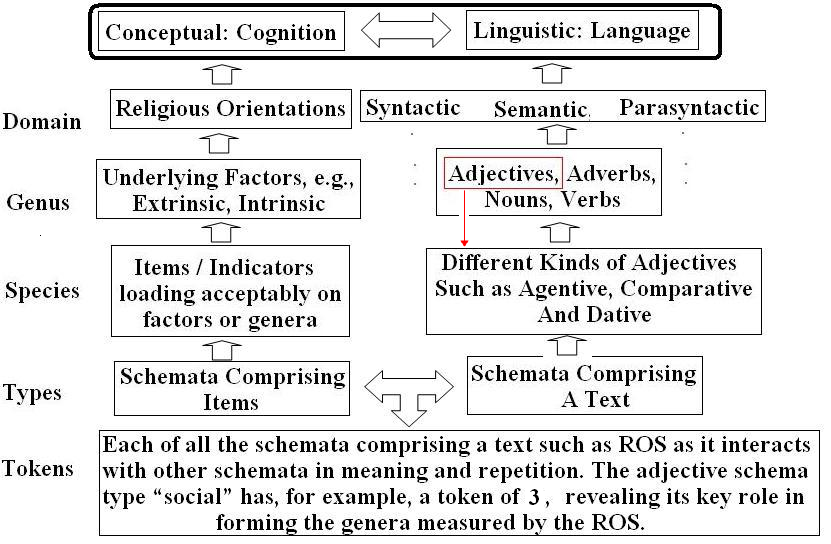 | Figure 1. Cognitive and linguistic categorization of schemata constituting the ROS (Khodadady & Bagheri, 2014, p. 166) |
|
|
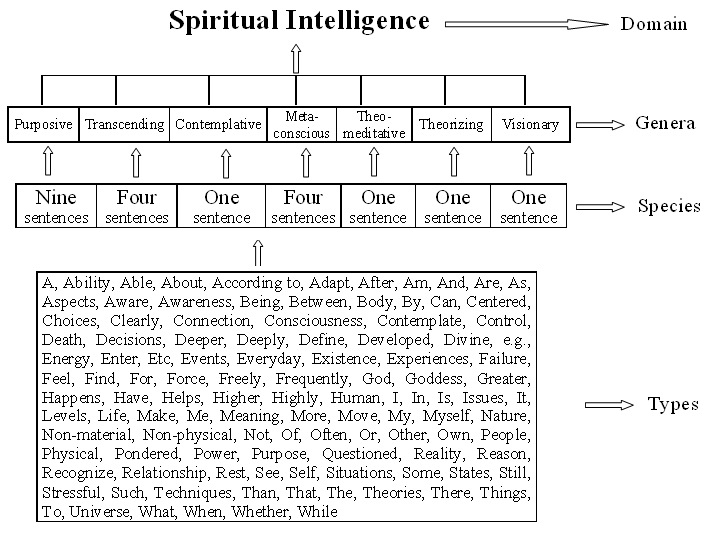 | Figure 2. Schema types, species and genera forming the cognitive domain of spiritual intelligence |
Appendix: Statements Comprising the SISRI
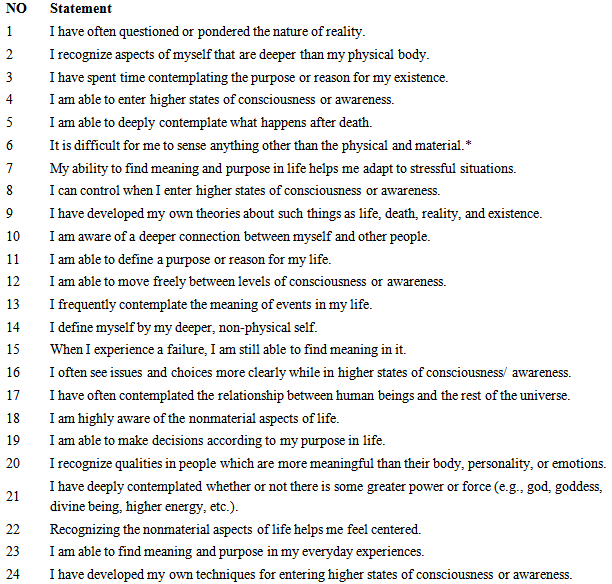
 Abstract
Abstract Reference
Reference Full-Text PDF
Full-Text PDF Full-text HTML
Full-text HTML